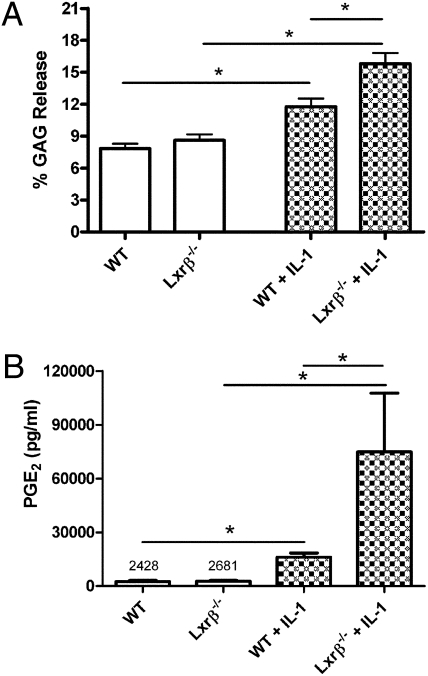Fig. 1.
(A) Increased aggrecan release upon IL-1β stimulation of mouse-hip cartilage from LXRβ null mice. Hip cartilage from 3-week-old wild-type (wt) C57BL/6 and Lxrβ−/− mice were collected and cultured in serum-free medium ± IL-1β (1.0 ng/mL) for 3 days. Treatment of mouse-hip cartilage with IL-1β alone for 3 days was sufficient to induce a significant increase of glycosaminoglycan (GAG) release to the culture medium. Amounts of GAG were measured using DMMB assay and expressed as the percentage of GAG in the media compared to the total GAG (the GAG released to the medium plus the GAG in the explant). No significant difference was observed in basal GAG release between the wt (n = 9) and Lxrβ−/− (n = 9) groups. Cytokine-induced GAG release was significantly greater from cartilage from Lxrβ−/− mice (n = 11) compared to wt mice (n = 10). Data points represent the mean values (±SEM) of the percentage of GAG release over 3 days of culturing. *P < 0.05, by one-way ANOVA (Bonferroni). (B) Increased PGE2 production by mouse-hip cartilage from LXRβ null mice as compared with cartilage explants from wt mice upon IL-1β treatment. Comparable basal PGE2 production was detected in cultures of cartilage explants from Lxrβ−/− (n = 12) and wt (n = 9) mice. Cytokine-induced PGE2 production from cartilage from Lxrβ−/− mice (n = 11) was significantly greater than from wt mice (n = 11). Data points represent the mean values (±SEM) of PGE2 levels in each group. *P < 0.05 by Mann–Whitney U test.

